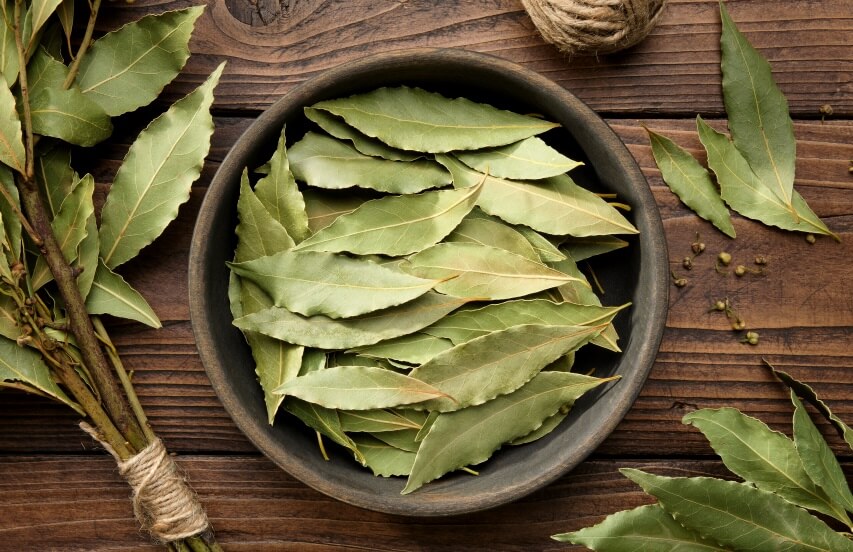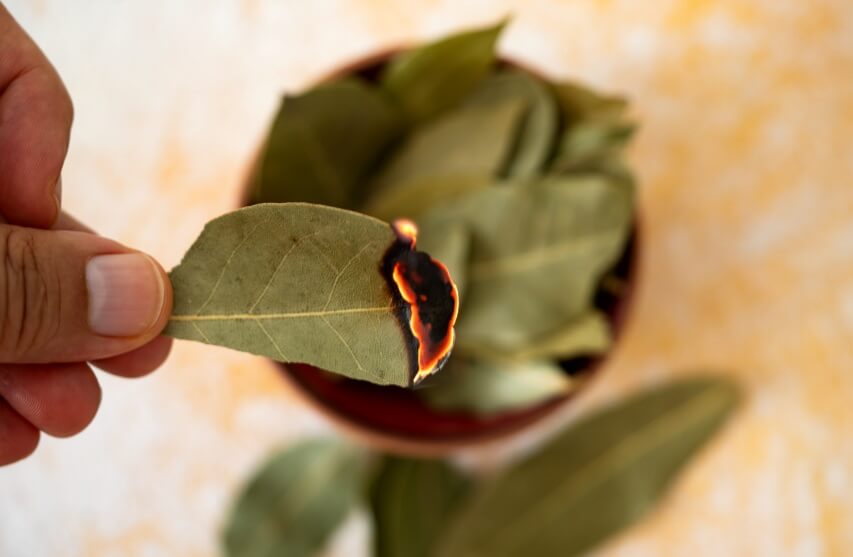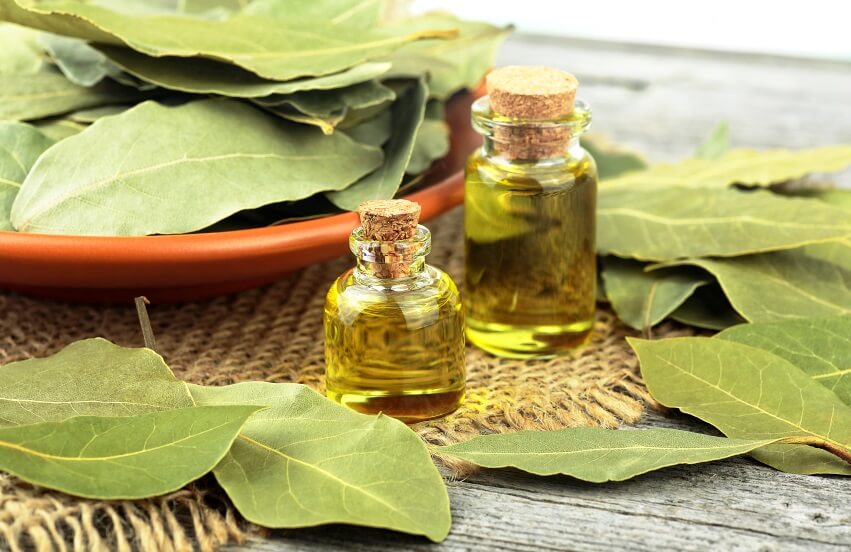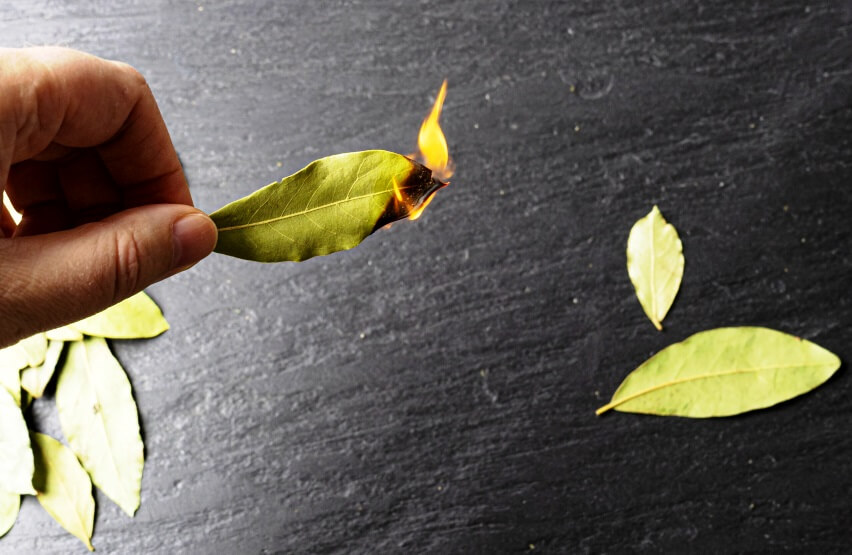Bay leaf, scientifically known as Laurus nobilis, is a perennial plant that falls under the laurel family (Lauraceae) and is cultivated extensively in Europe, Asia, and tropical regions. With a rich history spanning thousands of years, bay leaf has been cherished for its versatile uses in flavoring dishes, creating essential oils, and traditional medicinal practices.
Burning bay leaves has been a longstanding tradition across cultures, often employed for ceremonial or spiritual purposes. While scientific evidence backing specific health benefits is lacking, many individuals believe in its ability to foster relaxation, mental clarity, and air purification.
In this article, we’ll delve into the benefits of burning bay leaf and provide a guide on how to perform this practice.
If you are interested in this topic, you can also read
<<Fava Beans Benefits >> and <<Chrysanthemum Plants Benefits>> articles.
About Bay Leaves
This aromatic leaf harbors a diverse array of natural compounds, including tannins, flavones, flavonoids, alkaloids, eugenol, linalool, methyl chavicol, and anthocyanins. The specific combination of these bioactive substances can vary based on factors such as plant type and growth conditions, such as soil quality, climate, irrigation methods, pruning techniques, and other agricultural practices.
Beyond its culinary significance, bay leaf holds substantial importance in various industries like food, cosmetics, and pharmaceuticals. Its wide-ranging biological properties make it a standout ingredient with numerous health benefits.
Bay leaf is also known to aid in wound healing, function as an antioxidant, possess antibacterial, antiviral, and immunostimulant characteristics, as well as showcasing anticholinergic, antifungal, insect-repelling, anticonvulsant, antimutagenic, analgesic, and anti-inflammatory properties. The remarkable versatility of bay leaf extends beyond the kitchen, offering a myriad of health-promoting effects that cater not only to gastronomic enthusiasts but also to individuals seeking natural remedies for various ailments [1].
Why Should We Burn Bay Leaf?
The distinctive scent of bay leaf is characterized by its sharp and bitter taste, while its aromatic nuances stem from the presence of essential oils found in both the leaves and other parts of the plant.
Burning bay leaf serves a unique purpose as it transforms the raw material used in essential oil production into incense or smoke, resulting in a different blend of compounds. The burning process rapidly degrades the plant material, creating a chemical makeup distinct from traditional essential oils.
An analysis of the chemical components in bay leaf smoke reveals the predominant classes of compounds present. Oxygenated monoterpenes make up the largest portion at 44.84% of the smoke, followed by oxygenated compounds at 23.27%, sesquiterpenes at 22.40%, and monoterpene hydrocarbons at 6.78%. Key components identified in bay leaf smoke include methyl dihydro jasmonate at 14.72%, 1,8-cineole at 12.61%, terpinene-4-ol at 6.92%, trans-caryophyllene oxide at 5.00%, carvacrol at 4.76%, and citronellal at 4.04%.
This intricate composition contributes to the alluring aroma and potential therapeutic benefits of burning bay leaves for sensory enjoyment and potential wellness support [2].
Bay Leaf in Traditional Medicine
The tradition of inscribing wishes on bay leaves and burning them to manifest desires embodies a mystical charm that has transcended through generations. This ritual, practiced across diverse cultures, underscores the enduring significance of bay leaves in traditional and complementary medicine, dating back centuries. The act of burning bay leaves is steeped in the belief that it unlocks a host of health benefits, blending ancient wisdom with contemporary wellness practices.
Benefits Of Burning Bay Leaves At Home
Anxiety Relief
One popular notion surrounding burning bay leaves is their potential to relieve anxiety. This effect is often linked to the presence of linalool in bay leaf smoke, a compound that is also present in plants like mint and lavender and is known for its anxiety-reducing properties.
Lavender, in particular, is renowned for its calming effects on the mind. This phenomenon aligns with the principles of aromatherapy, which posit that inhaling specific fragrances can activate olfactory receptors, initiating a dialogue with brain regions responsible for regulating emotions. By engaging in the ritual of burning bay leaves, individuals may tap into this aromatic therapy to promote a sense of peace and tranquility in moments of stress and unease [3].
N Lakshmi, a Senior Dietician at Kamineni Hospitals in Hyderabad, acknowledges the growing trend of using burning bay leaves as a method to alleviate anxiety and stress, with advocates pointing to compounds like linalool and eucalyptol for their purported calming effects.
However, she notes that scientific backing for these claims remains scant. Lakshmi suggests that the calming ambiance fostered by the fragrance of burning bay leaves is likely a result of the relaxation brought about by immersing oneself in a sensory encounter rather than any direct influence of the leaves themselves. This perspective underscores the potential psychological benefits of engaging in rituals like burning bay leaves, which can create a serene atmosphere conducive to reducing feelings of tension and promoting mental well-being [4].
Boosting Immune System
Burning bay leaves is believed to have potential benefits for boosting the immune system due to the presence of compounds like eugenol, which possesses antioxidant properties. Additionally, bay leaves are rich in essential vitamins and minerals necessary for overall body function, further contributing to their immune-boosting potential. By burning and consuming bay leaves, individuals may support their immune system and enhance their overall well-being [5].
Positive Effect On Lung Health
Moreover, specialists suggest that the smoke from burning bay leaves could positively affect lung health by potentially cleansing the respiratory tract and lungs. Bay leaves are traditionally used to address chronic exhaustion and may help treat congested or blocked respiratory passages and lungs.
Another method for utilizing bay leaves to promote respiratory health involves soaking fresh leaves in water, using bay leaf oil in a humidifier to generate steam, boiling treated water on the stove with bay leaves, or applying the oil topically to the chest area.
These approaches can help alleviate respiratory issues, allergies, and asthma and promote clearer breathing by assisting in breaking down and eliminating mucus and phlegm. This natural remedy offers a holistic approach to respiratory care, harnessing the benefits of bay leaves for improved lung function and overall respiratory well-being [6].
Inflammation Reduction
Bay leaves are renowned for their medicinal properties, including their ability to reduce inflammation in the body, particularly in the joints. This anti-inflammatory effect is attributed to the presence of eugenol, a natural compound found in bay leaves known for its healing properties. By incorporating bay leaves into your routine, you may experience relief from inflammation and promote overall joint health [7].
Boosting Energy And Alertness
In addition to its anti-inflammatory effects, burning bay leaves can also boost energy levels and enhance alertness. The smoke produced by burning bay leaves has a dual impact of inducing calmness while simultaneously increasing alertness. This unique combination can combat feelings of chronic fatigue, with compounds like pinene, cineol, and elemicin in bay leaves working together to combat tiredness and provide a pleasant energy boost to those exposed to the smoke [8].
Relief From Pests
Furthermore, burning bay leaves can serve as an effective natural insect repellent, deterring pests like cockroaches, moths, and various other insects. The smoke emitted by burning bay leaves is known to repel these pests, offering a chemical-free and aromatic solution to keep unwanted insects at bay in your living space. Embracing the practice of burning bay leaves not only promotes health and vitality but also contributes to creating a pest-free environment, enhancing the overall well-being of your home [9].
How To Burn Bay Leaf At Home
Burning bay leaves safely is a simple process that can bring potential benefits. Here are steps to follow for burning bay leaves safely:
- Collect Dried Bay Leaves: Ensure you use dried bay leaves as they burn more easily than fresh ones. Dried bay leaves can be found in the spice section of most grocery stores.
- Use a Fireproof Bowl: Choose a fireproof container such as an ashtray, glass, or ceramic dish. Lining it with aluminum foil can help catch ash and keep the dish clean.
- Light the Leaf Carefully: Use a match or lighter to light the end of one bay leaf carefully. Once the flame catches, quickly blow it out to allow the leaves to smolder slowly instead of burning quickly.
- Place the Burning Leaf: Put the burning bay leaf in the fireproof container and keep it within sight, away from pets and children. Do not leave the burning leaves unattended.
- Crack a Window: Crack open a window to prevent the bay leaf smoke from triggering your smoke alarm. Avoid placing the burning dish beside the open window to prevent the breeze from spreading burning bits or ash.
- Allow to Smoke: Let the bay leaves smoke for 10 to 15 minutes. If they stop burning, relight them. It may take a few attempts to achieve a steady smoldering, especially if the leaves are slightly fresh.
- Dispose of Ash Safely: Once you’re done, ensure the ash completely cools before disposing of it or composting it. For added safety, you can splash the ash with some water before disposal [10].
By following these steps, you can safely burn bay leaves and potentially enjoy the aromatherapy benefits associated with this practice.












